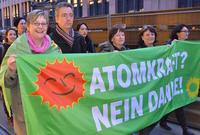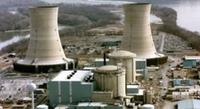-
Siemens, McAfee team up to defend against critical infrastructure attacks
McAfee and Siemens will work together to help secure critical infrastructure against cyber attacks that target industrial control processes like the Stuxnet worm which destroyed nuclear centrifuges at an Iranian nuclear enrichment facility; the two companies are targeting Advanced Persistent Threats aimed at the manufacturing and process industry; this new security product could help ease security fears for critical infrastructure operators who rely on industrial control programs for nearly every automated process; McAfee says it’s Application Control system product would have protected Iran’s centrifuges from the Stuxnet virus that caused them to spin out of control
-
-
Tennessee may spend millions to improve nuclear reactor safety
The Tennessee Valley Authority (TVA) is considering spending millions of dollars to bolster its six nuclear reactors against earthquakes and floods; TVA is the first American nuclear plant operator to declare safety changes following events in Japan; TVA is currently considering reducing the amount of fuel that it stores in its spent fuel pools instead transferring older fuel rods to passively cooled “dry casks” ; the operator will also add additional back up diesel generators, make improvements to electrical grids to make them more earthquake resistant, add small generators to recharge cell phone batteries and to keep lights on, and reinforce pipes that send cold water to spent fuel pools
-
-
Google invests $168 million in world’s largest solar tower
Google recently announced that it will invest $168 million to help fund a massive solar power project in California’s Mojave Desert; when completed the solar tower will be the world’s generating 392 megawatts of energy and powering 140,000 homes; the solar facility will be built by BrightSource Energy and has been dubbed the Ivanpah Solar Electric Generating System; BrightSource has already raised roughly $1.6 billion dollars including loan guarantees from the U.S. Department of Energy and a $300 million investment from NRG Energy Inc.; the tower is expected to reduce carbon dioxide emissions by 400,000 tons per year and is scheduled to be completed in 2013
-
-
Abandoning nuclear power would cost Germany billions

Nuclear power is highly unpopular in Germany, and in the wake of the nuclear disaster in Japan, Germany chancellor Angela Merkel announced that Germany would abandon nuclear power generation (she called it “Atomausstieg,” or “nuclear exit”) and would gradually close its seventeen nuclear power plants; there is a debate in Germany about whether abandoning nuclear power would cost Germany 3 billion Euros a year – or only 2 billion Euros, as the government says it would
-
-
Experts: new U.S. nuclear reactors unlikely soon

Experts on a panel at Stanford University say radiation leaks at Japan’s Fukushima plant could impact the future of nuclear energy in the United States and abroad; they said that nuclear safety improved after the historic disasters at Three Mile Island and Chernobyl. Richter, and that it was improved further after the 9/11 attacks; they expect similar safety reviews by the U.S. Nuclear Regulatory Commission following the Fukushima accident
-
-
House panel extends chemical plant safety act
In 2006, Congress first authorized DHS to regulate security at high-risk chemical facilities. In response, DHS developed the Chemical Facility Anti-Terrorism Standards (CFATS); to date, DHS has reviewed information submitted by more than 39,000 chemical facilities and determined that 4,744 are high-risk and, therefore, covered under CFATS; yesterday, a House panel voted for a 7-year extension of CFATS
-
-
Shoring up U.K. infrastructure essential to country's welfare
The United Kingdom suffers from some of the most congested infrastructure in the developed world and a failure to invest in these will have serious impacts upon the country’s long-term economic future; improvements to transport, energy, and ICT infrastructure could increase GDP by an additional 0.7 percent
-
-
Algae could replace 17% of U.S. oil imports
Environmental and economic security concerns have triggered interest in using algae-derived oils as an alternative to fossil fuels; growing algae, however — or any other biofuel source — can require a lot of water; researchers at the Pacific Northwest National Laboratory the far less water is required if the algae is grown in those regions in the United States that have the sunniest and most humid climates: the Gulf Coast, the Southeastern Seaboard, and the Great Lakes; water-wise algae farming could help meet congressionally mandated renewable fuel targets by replacing 17 percent of the U.S. imported oil for transportation
-
-
Interest in water technology and business grows
Some 3,000 foreign visitors and more than 25,000 local participants are expected to attend the November 2011 WATEC, one of the world’s premier water technology events; the emphasis of this year’s conference and exhibition, the be held in Israel 15-17 November, will be on showing how water technology translates into successful projects and enterprises — both for the developed world and those at risk of severe water insecurity; there are about 400 water technology companies in Israel; 200 of them are already exporting their technologies to other countries — exports estimated to be between $2.5 billion and $3.5 billion in 2010
-
-
New material cleans water of radioactive contamination
NC State researchers develops material to remove radioactive contaminants from drinking water; the material is a combination of forest byproducts and crustacean shells; the new material not only absorbs water, but can actually extract contaminates, such as radioactive iodide, from the water itself; this material, which forms a solid foam, has applications beyond radioactive materials
-
-
NRC inspects Nebraska reactor radiation exposure
On 3 April, workers at the Cooper Nuclear Station, located near Brownville, Nebraska removed a long tube contaminated with highly radioactive material through the bottom of the reactor vessel, rather than through the top as is usually done, triggering radiation alarms; the NRC is investigating
-
-
Streamlined approach to U.S. preparedness
The administration has released a new presidential policy directive on national preparedness; the directive, the result of a comprehensive review of national preparedness policy, replaces Homeland Security Presidential Directive 8; the administration says that the directive seeks to move away from burdensome requirements and instead build the key capabilities the nation needs to confront any challenge
-
-
Keeping water pure with detection nanosensors
Seven European countries, containing 35 percent of the European population, face a risk of water shortfall; University College Cork will coordinate a 3 million Euro EU project for the development of novel smart sensing materials for applications in water purification technology and clinical diagnostics
-
-
Five U.S. nuclear plants in earthquake zones
Five active U.S. nuclear reactors — the Diablo Canyon Power Plant and San Onofre Nuclear Generating Station in California; the South Texas Project near the Gulf Coast; the Waterford Steam Electric Station in Louisiana; and the Brunswick Steam Electric Plant in North Carolina — are situated in seismic activity-prone zones
-
-
New radar optimized for homeland security
A new radar is designed to provide an affordable, modular solution for border protection and coverage of wide areas, offering good detection capability of ground targets and aerial targets, specifically homeland security-relevant objects flying slow at very low level
-
More headlines
The long view
Water Wars: A Historic Agreement Between Mexico and US Is Ramping Up Border Tension
As climate change drives rising temperatures and changes in rainfall, Mexico and the US are in the middle of a conflict over water, putting an additional strain on their relationship. Partly due to constant droughts, Mexico has struggled to maintain its water deliveries for much of the last 25 years, deliveries to which it is obligated by a 1944 water-sharing agreement between the two countries.
Trump Is Fast-Tracking New Coal Mines — Even When They Don’t Make Economic Sense
In Appalachian Tennessee, mines shut down and couldn’t pay their debts. Now a new one is opening under the guise of an “energy emergency.”
Smaller Nuclear Reactors Spark Renewed Interest in a Once-Shunned Energy Source
In the past two years, half the states have taken action to promote nuclear power, from creating nuclear task forces to integrating nuclear into long-term energy plans.
Keeping the Lights on with Nuclear Waste: Radiochemistry Transforms Nuclear Waste into Strategic Materials
How UNLV radiochemistry is pioneering the future of energy in the Southwest by salvaging strategic materials from nuclear dumps –and making it safe.
Model Predicts Long-Term Effects of Nuclear Waste on Underground Disposal Systems
The simulations matched results from an underground lab experiment in Switzerland, suggesting modeling could be used to validate the safety of nuclear disposal sites.
